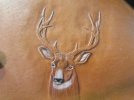I am far from an expert but I have gone through what you are experiencing a number of years ago. As Paul says, Al Stohlman's books are absolutely some of the best help out there. The one that helped me the most with antlers was his Figure Carving Finesse book.
I learned that the three most important things were accurate pattern transfer, precise cutting and careful beveling. The attached photo is of a case I did years ago. It was probably my 5th or 6th try at that figure and even then it is far from perfect. The horns really need to be rounded more with modeling tools and the beveling can be improved a lot. To do this I made a very pointed stylus tool to transfer the pattern to the leather. The typical commercial stylus has too big a point for the fine lines needed. I used a very sharp angle blade and took a lot of time to ensure I cut on the lines at the proper depth. The beveling was done with special figure carving bevelers that have much less angle than the regular ones. However, any will work if you are careful how you hold it. I also believe smooth ones tend to look better on figures like this because you can make the figure really pop out of the background (my wife tried to help with the background by painting my work room without covering anything; hence the white dots and shading around the horns). I also made a lot of use of small modeling spoons to work the fine detail. Sometimes mallets are too much, no matter how careful.
Be patient and practice. I have a lot of scrap leather with practice carvings and each taught me something.
Randy
View attachment 595850
 [/URL][/IMG]
[/URL][/IMG]

